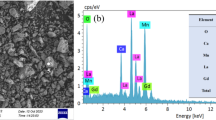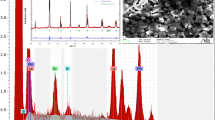Abstract
A theoretic work on magnetocaloric properties of the polycrystalline La0.6Ca0.4MnO3 system near a second-order phase transition from a ferromagnetic to a paramagnetic state is presented. The value of the magnetocaloric effect has been determined from the calculation of magnetization as a function of temperature under different external magnetic field shifts. The magnetic entropy change ∆S M reaches a peak of about 3 J kg−1 K−1 at 266 K upon 1.60 KA/m applied field variation. The ∆S M distribution is much more uniform than that of gadolinium, which is desirable for an Ericson-cycle magnetic refrigerator, which is beneficial for the household application of active magnetic refrigerant materials.
Similar content being viewed by others
Explore related subjects
Discover the latest articles, news and stories from top researchers in related subjects.Avoid common mistakes on your manuscript.
Introduction
The refrigeration by magnetocaloric effect (MCE) and electrocaloric effect (ECE) offer a lot of clear advantages over the conventional gas compression refrigeration technology [1–9]. These provide efficient and environment-friendly solutions for cooling. It is more efficient, inexpensive, and environmentally friendly for replacing the current refrigerators using greenhouse gases that are harmful to environment and contributing to global warming.
Characterization and application of the magnetic properties of ferromagnetic particles become increasingly important for the level of miniaturization and reliability necessary for commercialization [10].
Perovskite manganites have attracted significant attention since the discovery of colossal magnetoresistance and several interesting properties of these compounds have been found. In recently years, there has been an increasing interest in using manganites not only as a material having colossal magnetoresistivity but also as a material with interesting magnetocaloric properties [11–13].
A large magnetocaloric effect makes manganites excellent candidates for working materials in magnetic refrigeration units especially because they are less costly than other materials, particularly those based on Gd.
In this paper, theoretic work on magnetization versus temperature in different magnetic field shifts for polycrystalline La0.6Ca0.4MnO3 system. It is used a phenomenological model for simulation of magnetization dependence on temperature variation to predict magnetocaloric properties such as magnetic entropy change, heat capacity change, temperature change, and relative cooling power.
Theoretic considerations
According to phenomenological model in Hamad [14], the dependence of magnetization on variation of temperature and Curie temperature T c is presented by
where M i is an initial value of magnetization at ferromagnetic–paramagnetic transition and M f is a final value of magnetization at ferromagnetic–paramagnetic transition as shown in Fig. 1.
B is magnetization sensitivity \( \frac{{d{\text{M}}}}{{d{\text{T}}}} \) at ferromagnetic state before transition, S c is magnetization sensitivity \( \frac{{d{\text{M}}}}{{d{\text{T}}}} \) at Curie temperature T C and
A magnetic entropy change of a magnetic system under adiabatic magnetic field variation from 0 to final value H max is available by
The foundation of large magnetic entropy change is attributed to high magnetic moment and rapid change of magnetization at T c. A result of Eq. (2) is a maximum magnetic entropy change \( \Updelta S_{ \hbox{Max} } \) (where T = T C) can be evaluated as following the equation
Eq. (3) is an important equation for taking into consideration of value of the magnetic entropy change to evaluate magnetic cooling efficiency with its full-width at half-maximum.
A determination of full-width at half-maximum\( \left( {{{\updelta}}T_{\text{FWHM}} } \right) \) can be evaluated as follows:
This equation gives a full-width at half-maximum magnetic entropy change contributing for estimation of magnetic cooling efficiency as follows.
A magnetic cooling efficiency is estimated by considering magnitude of magnetic entropy change, \( \Updelta S_{\text{M}} \) and its full-width at half-maximum \( \left( {{{\updelta}}T_{\text{FWHM}} } \right) \) [13]. A product of \( - {{\Updelta}}S_{ \hbox{Max} } \) and \( \delta {\text{T}}_{\text{FWHM}} \) is called relative cooling power (RCP) based on magnetic entropy change.
The magnetization-related change of the specific heat is given by [13]
According this model [14], \( {{\Updelta}}C_{\text{P,H}} \) can be rewritten as
A temperature change of a magnetic system under adiabatic magnetic field variation from 0 to H max can be written in the form
C p is the heat capacity per mole at constant magnetic field.
From this phenomenological model, it can easily assess the values of δT FWHM, |∆S| max, RCP, and ∆T for La0.6Ca0.4MnO3 under magnetic field variation.
Theoretic work
Numerical calculations were made with parameters as displayed in Table 1. A heat capacity C p = 550 J kg−1 K−1 [15, 16]. Figure 2 shows the magnetization versus temperature in different applied magnetic field shifts for La0.6Ca0.4MnO3 polycrystals have been prepared by a non-standard ceramic method with presintering at 1,100 °C and final sintering at 1,350 °C. The symbols represent experimental data from ref. [12], while the dashed curves represent modeled data using model parameters given in Table 1. It is seen that for the given parameters, the results of calculation are in a good agreement with the experimental results. Furthermore, Figs. 3, 4, and 5 show predicted values for changes of magnetic entropy, specific heat, and temperature versus temperature. Magnetic entropy change in La0.6Ca0.4MnO3 is reported in Fig. 3 and shows an increase in |∆SM| with increasing ∆H. The magnetic entropy change curves reveal the characteristics of the spin reorientation by the kinks in the ∆S M curve. The maxima observed in the ∆S M curves are associated to a spin reorientation that occurs continuously. The behavior of curves suggests how to extend the range of temperatures for use in the MCE.
Magnetization in different applied magnetic field shifts for the La0.6Ca0.4MnO3 versus temperature. The dashed curves are modeled results and symbols represent experimental data from ref. [12]
The values of maximum magnetic entropy change, full-width at half-maximum, and relative cooling power at different magnetic field shifts for La0.6Ca0.4MnO3 are calculated by Eqs. 3–5, respectively, and tabulated in Table 2. Furthermore, the maximum and minimum values of specific heat change for each sample is determined from Fig. 4.
Both ∆S M and ∆T reflect a fundamental importance on the understanding of the behavior of the MCE, and these terms can be approximately estimated by Eqs. 2 and 8, respectively. As shown in Fig. 3, ∆S M reaches a peak of about 3 J kg−1 K−1 at 266 K upon 1.60 KA/m applied field variation. Though the maximum ∆S M is 1.92 J kg−1 K−1 upon 0.80 KA/m applied field variation which is about 70 % of that of a pure Gd metal 2.8 J kg−1 K−1 upon 0.80 KA/m, the ∆S M distribution of the La0.6Ca0.4MnO3 is much more uniform than that of gadolinium [17, 18]. This feature is desirable for an Ericsson-cycle magnetic refrigerator [19].
Although La0.6Ca0.4MnO3 is very similarly to research La0.67Ca0.33MnO3 in Hamad [14], the magnetic entropy changes of La0.6Ca0.4MnO3 and La0.67Ca0.33MnO3 have great difference. This due to the methods and conditions of synthesizing of two samples are different. Moreover, the former has a polycrystalline structure, while the latter has a single crystalline structure.
In general, the large magnetic entropy change in perovskite manganites has been believed to be related to the considerable variation of magnetization near T C [20]. The spin–lattice coupling in the magnetic ordering process could play a significant role in additional magnetic entropy change [21]. Owing to the strong coupling between spin and lattice, significant lattice change accompanying magnetic transition in perovskite manganites has been observed [22, 23]. The lattice structural change in the Mn–O bond distance as well as Mn–O–Mn bond angle would, in turn, favor the spin ordering. Thereby, a more abrupt reduction of magnetization near T C occurs and results in a significant magnetic entropy change [16, 24–26]. In this way, a conclusion might be drawn that a strong spin–lattice coupling in the magnetic transition process would lead to additional magnetic entropy change near T C, and consequently, favors the MCE.
Conclusions
Dependence of the magnetization on temperature variation for La0.6Ca0.4MnO3 upon different magnetic fields was simulated. In general, this allows the prediction of magnetocaloric properties of La0.6Ca0.4MnO3 such as magnetic entropy change, full-width at half-maximum, relative cooling power, and magnetic specific heat change for La0.6Ca0.4MnO3 upon different magnetic field shifts. Though the maximum ∆S M is about 70 % of that of gadolinium, the ∆S M distribution is much more uniform than that of gadolinium, which is desirable for an Ericsson-cycle magnetic refrigerator, which is beneficial for the household application of active magnetic refrigerant materials.
References
Oliveira NA, Ranke PJ. Theoretical aspects of the magnetocaloric effect. Phys Rep. 2010;489:89.
Gschneidner KA, Pecharsky VK, Tsoko AO. Recent developments in magnetocaloric materials. Rep Prog Phys. 2005;68:1479–539.
Szymczak R, Czepelak M, Kolano R, Burian AK, Krzymanska B, Szymczak H. Magnetocaloric effect in La1– x Ca x MnO3 for x = 0.3, 0.35, and 0.4. J Mater Sci. 2008;43:1734–9.
Hamad MA. Magneto-caloric effect in Ge0.95Mn0.05 films. J Supercond Nov Magn. 2012. doi:10.1007/s10948-012-1762-3.
Hamad MA. Magnetocaloric effect in polycrystalline Gd1-xCaxBaCo2O5.5. Mater Lett. 2012;82:181–3.
Hamad MA. Calculation on electrocaloric properties of ferroelectric SrBi2Ta2O9. Ph Transitions. 2012;85:159–68.
Hamad MA. Investigations on electrocaloric properties of [111]-oriented 0.955PbZn1/3Nb2/3O3–0.045PbTiO3 single crystals. Ph Transitions. 2012. doi:10.1080/01411594.2012.674527.
Hamad MA. Detecting giant electrocaloric effect in SrxBa1−xNb2O6 single crystals. Appl Phys Lett. 2012;100:192908.
Hamad MA. Theoretical investigations on electrocaloric properties of relaxor ferroelectric 0.9PbMg1/3Nb2/3O3-0.1PbTiO3 thin film. J Comput Electron. 2012. doi:10.1007/s10825-012-0414-y.
Hamad MA. Prediction of energy loss of Ni0.58Zn0.42Fe2O4 nanocrystalline and Fe3O4 nanowire arrays. Jpn J Appl Phys. 2010;49:085004.
Banerjee S, Kumar A, Devi PS. Preparation of nanoparticles of oxides by the citrate–nitrate process. J Therm Anal Calorim. 2011;104:859–67.
Szymczak R, Czepelak M, Kolano R, Burian AK, Krzymanska B, Szymczak H. Magnetocaloric effect in La1–xCaxMnO3 for x = 0.3, 0.35, and 0.4. J Mater Sci. 2008; 43:1734–1739.
Hamad MA. Theoretical work on magnetocaloric effect in ceramic and sol-gel La0.67Ca0.33MnO3. J Therm Anal Calorim. 2012. doi:10.1007/s10973-012-2505-1.
Hamad MA. Prediction of thermomagnetic properties of La0.67Ca0.33MnO3 and La0.67Sr0.33MnO3. Ph Transitions. 2012;85:106–12.
Kumar N, Kishan H, Rao A, Awana VPS. Structural, electrical, magnetic, and thermal studies of Cr-doped La0.7Ca0.3Mn1−xCrxO3 (0 ≤ x ≤ 1) manganites. J Appl Phys. 2010;107:083905.
Bohigas X, Tejada J, Sarrion MLM, Tripp S, Black R. Magnetic and calorimetric measurements on the magnetocaloric effect in La0.6Ca0.4MnO3. J Magn Magn Mater. 2000;208(1–2):85–92.
Goodenough JB. Theory of the role of covalence in the perovskite-type manganites [La, M(II)]MnO3. Phys Rev. 1955;100:564.
Dan’kov SY, Tishin AM, Pecharsky VK, Gschneidner KA. Magnetic phase transitions and the magnetothermal properties of gadolinium. Phys Rev B. 1998;57:3478.
Pecharsky VK, Gschneidner KA. Magnetocaloric effect and magnetic refrigeration. J Magn Magn Mater. 1999;200:44–56.
Bohigas X, Tejada J, Barco E, Zhang XX, Sales M. Tunable magnetocaloric effect in ceramic perovskites. Appl Phys Lett. 1998;73:390.
Guo ZB, Du YW, Zhu JS, Huang H, Ding WP, Feng D. Large magnetic entropy change in perovskite-type manganese oxides. Phys Rev Lett. 1997;78:1142.
Radaelli PG, Cox DE, Marezio M, Cheong SW, Schiffer PE, Ramirez AP. Simultaneous structural, magnetic, and electronic transitions in La1−xCaxMnO3 with x = 0.25 and 0.50. Phys Rev Lett. 1995;75:4488.
Kim KH, GU JY, Choi HS, Park GW, Noh TW. Frequency shifts of the internal phonon modes in La0.7Ca0.3MnO3. Phys Rev Lett. 1996;77:1877.
Tang T, Gu KM, Cao QQ, Wang DH, Zhang SY, Du YW. Magnetocaloric properties of Ag-substituted perovskite-type manganites. J Magn Magn Mater. 2000;222:110–4.
Phan MH, Yu SC. Review of the magnetocaloric effect in manganite materials. J Magn Magn Mater. 2007;308:325–40.
Sun Y, Tong W, Zhang YH. Large magnetic entropy change above 300 K in La0.67Sr0.33Mn0.9Cr0.1O3. J Magn Magn Mater. 2001;232:205–8.
Author information
Authors and Affiliations
Corresponding author
Rights and permissions
About this article
Cite this article
Hamad, M.A. Magnetocaloric properties of La0.6Ca0.4MnO3 . J Therm Anal Calorim 113, 609–613 (2013). https://doi.org/10.1007/s10973-012-2723-6
Received:
Accepted:
Published:
Issue Date:
DOI: https://doi.org/10.1007/s10973-012-2723-6









